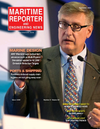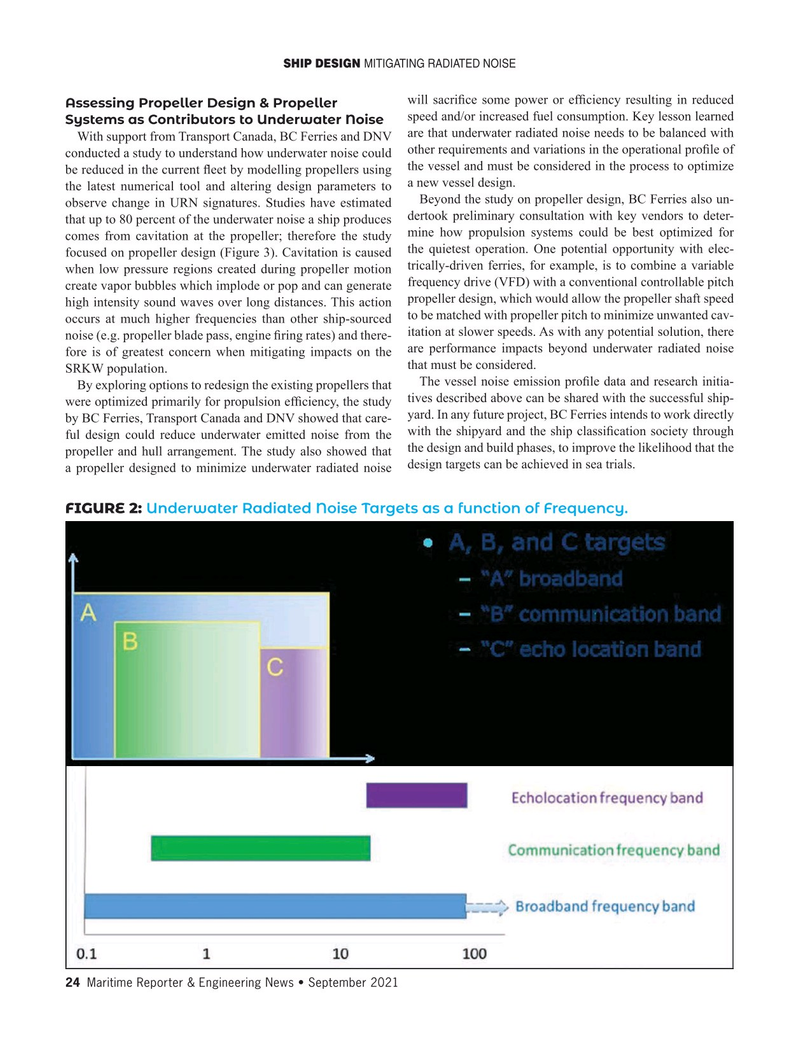
Page 24: of Maritime Reporter Magazine (September 2021)
The Marine Design Edition
Read this page in Pdf, Flash or Html5 edition of September 2021 Maritime Reporter Magazine
SHIP DESIGN MITIGATING RADIATED NOISE will sacri? ce some power or ef? ciency resulting in reduced
Assessing Propeller Design & Propeller speed and/or increased fuel consumption. Key lesson learned
Systems as Contributors to Underwater Noise are that underwater radiated noise needs to be balanced with
With support from Transport Canada, BC Ferries and DNV conducted a study to understand how underwater noise could other requirements and variations in the operational pro? le of be reduced in the current ? eet by modelling propellers using the vessel and must be considered in the process to optimize the latest numerical tool and altering design parameters to a new vessel design.
Beyond the study on propeller design, BC Ferries also un- observe change in URN signatures. Studies have estimated that up to 80 percent of the underwater noise a ship produces dertook preliminary consultation with key vendors to deter- comes from cavitation at the propeller; therefore the study mine how propulsion systems could be best optimized for focused on propeller design (Figure 3). Cavitation is caused the quietest operation. One potential opportunity with elec- when low pressure regions created during propeller motion trically-driven ferries, for example, is to combine a variable create vapor bubbles which implode or pop and can generate frequency drive (VFD) with a conventional controllable pitch high intensity sound waves over long distances. This action propeller design, which would allow the propeller shaft speed occurs at much higher frequencies than other ship-sourced to be matched with propeller pitch to minimize unwanted cav- itation at slower speeds. As with any potential solution, there noise (e.g. propeller blade pass, engine ? ring rates) and there- fore is of greatest concern when mitigating impacts on the are performance impacts beyond underwater radiated noise that must be considered.
SRKW population.
The vessel noise emission pro? le data and research initia-
By exploring options to redesign the existing propellers that were optimized primarily for propulsion ef? ciency, the study tives described above can be shared with the successful ship- yard. In any future project, BC Ferries intends to work directly by BC Ferries, Transport Canada and DNV showed that care- ful design could reduce underwater emitted noise from the with the shipyard and the ship classi? cation society through propeller and hull arrangement. The study also showed that the design and build phases, to improve the likelihood that the a propeller designed to minimize underwater radiated noise design targets can be achieved in sea trials.
FIGURE 2: Underwater Radiated Noise Targets as a function of Frequency.
24 Maritime Reporter & Engineering News • September 2021
MR #9 (18-33).indd 24 9/7/2021 12:46:39 PM

 23
23

 25
25
